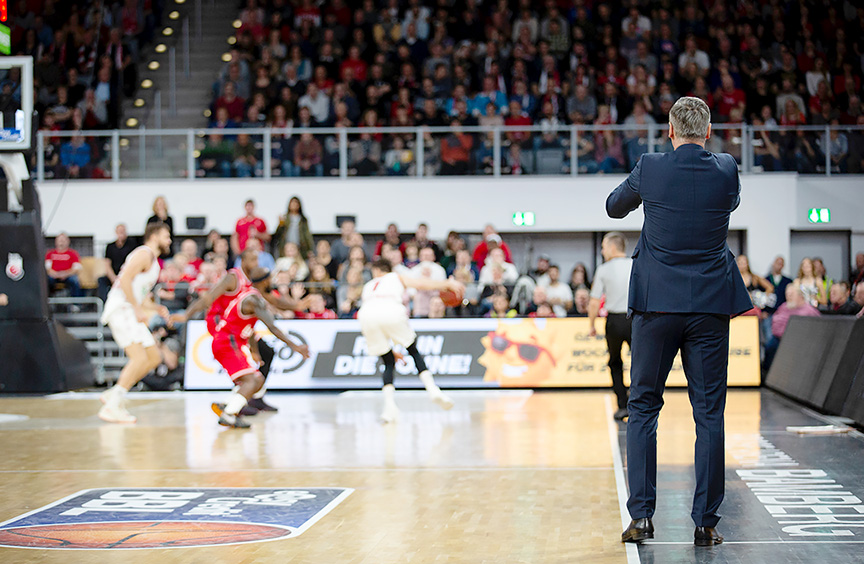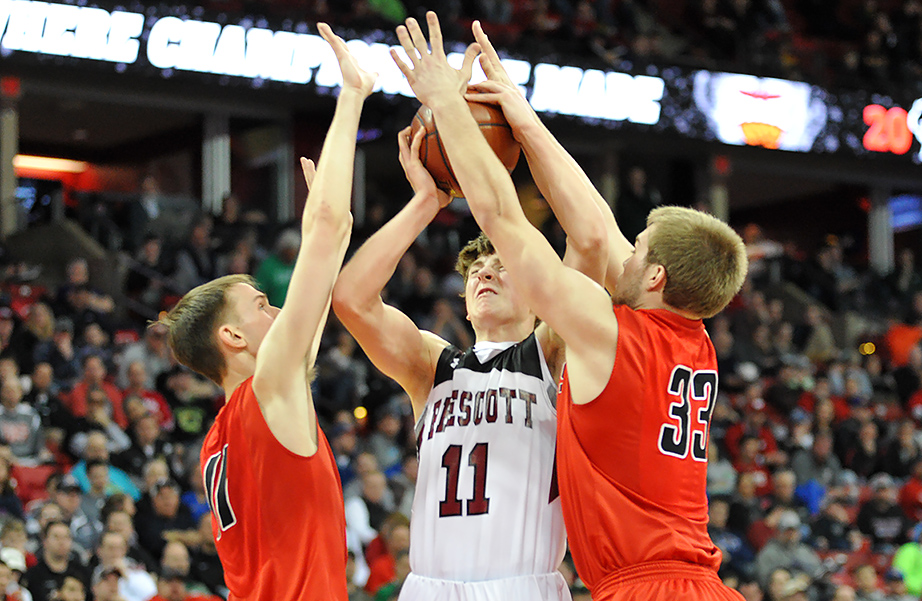10 creative methods for ‘selling’ defense to your players
It may sound like a cliché, but our program strongly believes that we win championships with defense. We also believe that the foundation of any quality program is based on defense.

It doesn’t matter what type of defense you play as long as your players are properly prepared and motivated to execute it. As a coach, you must understand the principles of your defense, how to drill the defense and, most importantly, how selling defense makes a difference. If your players wholeheartedly buy into your defensive philosophy and if they truly believe that it works, the effort, dedication and execution will follow.
The following 10 ideas are extremely important to selling defense to players every day.
1. Lockeroom slogans.
Every program should adopt defensive slogans that illustrate and identify your team’s emphasis on defense. Above our chalkboard, we have a sign that reads, “Defense wins.” As you leave our locker room, you’ll see a sign posted next to the door that says,“There is no homecourt advantage in rebounding and defense.”
These motivational signs must be strategically placed in your locker room, weight room or practice areas for constant visibility. But don’t overdo it with the signs. Too many signs decreases the significance of the message that you’re trying to convey. Carefully pick and choose the slogans with which you’re using when selling defense to players.
2. Practice gear.
Every day, when our players put on their practice gear, they see the slogan “defense wins” embroidered on their shorts. We like to put it on the players’ left leg of the shorts, embroidered so that it’s upside down. That way, when the players are stretching or looking down, “defense wins” will be readable.
» ALSO SEE: Footwork, conditioning drills for ball-hawking defenders
This sounds simple, yet it’s another reminder to our players that we’re defense-orientated and we’re always thinking about it. Sooner or later, this emphasis begins to permeate and sinks in to the players’ subconscious.
We’ve all seen different slogans used by teams around the country. We prefer to stay with the same slogan from season to season so that it doesn’t become too gimmicky.
3. Defense first.
All of our team’s practice sessions begin with a defensive warm-up drill. The majority of the first hour is devoted to basic defensive drills that reinforce individual and team defensive concepts.

With the average player, it takes 30 days to make or break a bad habit. Stressing defensive fundamentals for the first hour of practice forces the necessary repetitions to break poor habits. We carry this tactic from the first practice to the last practice each season.
4. Defensive efficiency rating.
Early on, you must decide which defensive statistic is most important to your evaluation of quality defensive play. The barometer of our defensive play is based on the defensive efficiency rating (DER), which used to measure our opponent’s points allowed per possession.
If an opponent, for example, were to have 85 possessions in a game and score 80 points, it would equate to a DER of 0.94. We also place a tremendous emphasis on “defensive points allowed,” as we want to build a defensive mentality into our players of not conceding baskets or points during a game.
Many coaches prefer to use “scoring margin” or “defensive field-goal percentage” as a gauge for defensive effectiveness. No matter the metric, pick one or two areas you can emphasize. Consistently refer to them in your team chalk talks and 1-on-1 player evaluations. This lets players know that you’re keeping a statistical account of the defensive side of the floor.
5. Set tangible goals.
Our coaches are big believers in setting goals. We set and track season-long defensive goals, as well as individual game defensive goals. We’d like our team to be ranked nationally in scoring defense. We also want to be ranked in the top third in all of the defensive team statistics in our conference.
The defensive goals we set for each game are as follows:
- Win the game.
- Secure 53% of all rebounds (defensive and offensive). These drills can help.
- Attain a defensive 3-point field-goal percentage of 35%, and a defensive field-goal percentage of 45%.
- Force a 22% turnover rate.
- Hold the opponent to under 70 points.
- Allow no opposing player to score more than 19 points.
- Shoot more free throws than our opponent. Ideally, we want to make more free throws than our opponent attempts.
- Have a DER of under 1.00.
- Closely contest 40% or more of all shots.
- Have 30 or more deflections.
- Force the opposing team to commit two or more turnovers or to call timeouts on baseline or sideline inbounds plays.
Setting goals goes a long way toward giving you a barometer for how well your defense is performing. It also gives coaches an indicator for the areas that you need to improve upon defensively.
6. Defensive awards.
We give a defensive player “game-ball” award following every win. To be considered for the award, a player must have turned in a solid defensive effort no matter how many points they may have scored or how many rebounds were grabbed.
» ALSO SEE: ‘Heart Drill’ tests effort on defense
On rare occasions, we’ll hand out a “Mad Dog” defensive award to a player. This award goes to a player who had an outstanding defensive game against a great scoring player. The Mad Dog award is given out sparingly to keep it special.
We have also used a “star” program for reaching individual defensive standards for defensive categories. Those include deflections, rebounds, drawn charges, blocked shots and defensive helps. The stars are sewn on to the players’ shorts in a similar fashion to football helmet stickers that some football teams give out to players who had a good game.
7. Defensive bulletin board.
 Our coaching staff is always searching for quotes from players and coaches who are talking about defense. When we come across a quote, we’ll post it on a special defensive bulletin board in our locker room. Our players really respond to this. When they see top college and professional players and coaches giving defense credit for their success, it gets their attention.
Our coaching staff is always searching for quotes from players and coaches who are talking about defense. When we come across a quote, we’ll post it on a special defensive bulletin board in our locker room. Our players really respond to this. When they see top college and professional players and coaches giving defense credit for their success, it gets their attention.
Players sometime buy into defense when they read what others are saying about it. Strangely enough, we’ve also found that the players who pay the most attention to this board often become excellent assistant or head coaches.
We also love to put up quotes from our opponents who say positive things about our team’s defense. We always post national and conference defensive statistic on this board. This board is only used for selling defense, and it really gets players thinking about it.
8. Playing time.
The real test to your commitment is whether you reward people with playing time for quality defensive. Or, sit players for lackluster defensive effort and efficiency.
Any time that you ignore someone’s defensive play — for whatever the reason — the players on the team will see through it. When you fall behind in a game and make a comeback, it’s almost always due to your defense — not your offense. Therefore, this automatically indicates who will be on the floor when we fall behind and need some defensive stops.
Our best defensive player always starts. Without exception and no matter their talent level on offense. This is a true example to your players that the coaching staff not only watches for defensive effort, but places a premium on it.
9. Defensive chalk talks.
We always begin our preparations for an upcoming opponent by discussing how we will defend them. We’ll hold a brief “defense only” meeting and talk about the things that will help us win.
Our last reminders in pregame talks focus on how we’ll need to defend the opponent and what we need to do to achieve a quality DER. Our half-time talks begin with our up-to-date DER for the first half and what we need to do to make defensive adjustments.
For our post-game talks, we always post the DER on the board. When the DER meets our set goal and we win the game, we celebrate and make several short comments on what was done correctly defensively. If we’ve failed to meet our set goals for the DER and we’ve lost the game, we’ll discuss the defensive breakdowns, what was done wrong, and how we could have corrected it. We always find one defensive positive to comment on before we move on.
10. Defense always.
We’re fanatic about selling defense to our players, the fans, media and other coaches. We want opposing coaches to respect our defense to the point that they make special adjustments when they play our team. We want everyone we’ll be playing to feel that we’re the toughest defensive opponent on their schedule. They should believe that no one defends as well as we do and that we’re considered a “special preparation” team because of it.
Whenever our coaching staff has an opportunity to speak at clinics and lectures, we want the topic to be about defense. When my assistant coaches work basketball camps in the summer, I want them to immediately volunteer to work the defensive stations. When we submit articles to coaching publications, we want to write about defensive ideas and concepts.
We want our program to be nationally recognized for our defense. And most importantly, we want our players to feed off our coaching staff’s intensity, energy and enthusiasm for defense.
Make your team believe it has an edge by selling defense on a consistent basis.









